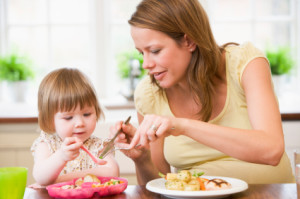Does She Ever Get Ice Cream?
/ Guest post on the Love Child Organics Blog: http://www.lovechildorganics.com/blog/
Guest post on the Love Child Organics Blog: http://www.lovechildorganics.com/blog/
A parent asked the following question:
How to handle dessert and treats. If a three year old never eats much of her meals, and we’re not meant to say, “no ice-cream unless you eat your dinner” does she ever get ice-cream?
This is a question that I’m asked all the time. In fact, it’s probably the most common preschooler nutrition question that I’m asked!
It’s very common for there to be a rule that kids must eat a certain number of bites of their vegetables/protein-foods/ dinner in order to “earn” dessert or treats.
The intentions behind it are laudable – you’re a good parent who wants your kids to eat healthy food and get good nutrition.
However, this rule not only starts mealtime battles, it actually teaches kids the opposite of what you’re intending.
Afterall, if you say that your child needs to eat 4 bites of broccoli before ‘earning’ her ice cream, then it opens the door for her to negotiate with you for only 3 or 2 bites. Or, for the size of the bites to be miniscule. It’s frustrating for you. And it’s a fantastic power struggle game that your preschooler will love.
What this rule is actually teaching kids is that healthy food is an awful chore that deserves to be rewarded. And, it reinforces that the treat food is amazing.
Studies show that kids who need to ‘earn’ treat foods in this way, when given unrestricted access to treats, will eat more of them, and at the expense of healthier foods. In other words, while making your child eat those 2 bites of broccoli before getting ice cream may get some broccoli into your child today, it’s at the expense of your child learning to choose to eat (and enjoy) broccoli.
So the parent who submitted the question is right – I recommend not saying “no ice-cream unless you eat your dinner”.
Instead, I recommend that you do what I call ‘control the menu’.
You choose what’s going to be served at each meal and snack. Sometimes this includes ice cream and other treats. Allow your child to eat as much as she/he wants of any and all the foods that you’ve served.
Yes, this may mean that she eats nothing but ice cream for dinner. It’s tough, but you need to let it go (as a dietitian I admit that I find this difficult too).
The way to influence your child to choose healthier foods is to: 1. Control how often ice cream (and other treats) are on the menu. For example, dessert isn’t served every night. 2. Role model eating (and enjoying) your non-treat foods in addition to your ice cream.
By using these two strategies, you’ll not only get healthy food into your child today, but you’ll be instilling in them a life-long habit of healthy eating.


 A big thank you to the parent who shared this question: "How much is enough food for my baby? Tonight I thought I would give in and see how it went. He polished off…….
While she was specifically talking about how much food to provide at bedtime snack, I’m asked this question a lot, in fact I’m asked it at almost every workshop.
A big thank you to the parent who shared this question: "How much is enough food for my baby? Tonight I thought I would give in and see how it went. He polished off…….
While she was specifically talking about how much food to provide at bedtime snack, I’m asked this question a lot, in fact I’m asked it at almost every workshop.
 I received the following question from a parent: "…reading about how "you may have to serve a particular food as many as X times before they will eat it": is there really progress in serving a food if kids consistently DON'T eat it? Like don't even try it / does not go anywhere near their mouth or even their hand? I feel as though I have probably served various vegetables to my son well over a hundred times and he still doesn't eat them, and still doesn't even come close to trying them. And frankly, I wonder how he will ever come to try them since he seems stubborn enough to continue dodging them for many years to come...
I received the following question from a parent: "…reading about how "you may have to serve a particular food as many as X times before they will eat it": is there really progress in serving a food if kids consistently DON'T eat it? Like don't even try it / does not go anywhere near their mouth or even their hand? I feel as though I have probably served various vegetables to my son well over a hundred times and he still doesn't eat them, and still doesn't even come close to trying them. And frankly, I wonder how he will ever come to try them since he seems stubborn enough to continue dodging them for many years to come...

 Thank you to the parent who sent in the following request for an article topic asking do toddlers like one-pot meals. In her own words “…whether toddlers tend to like a bunch of different foods in one plate (e.g. lots of choice), or a couple of choices, or a "one-pot meal")”
I can answer this in one phrase – all of the above.
Thank you to the parent who sent in the following request for an article topic asking do toddlers like one-pot meals. In her own words “…whether toddlers tend to like a bunch of different foods in one plate (e.g. lots of choice), or a couple of choices, or a "one-pot meal")”
I can answer this in one phrase – all of the above.

